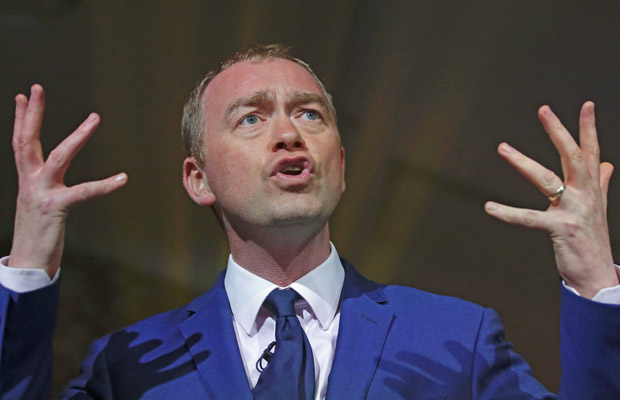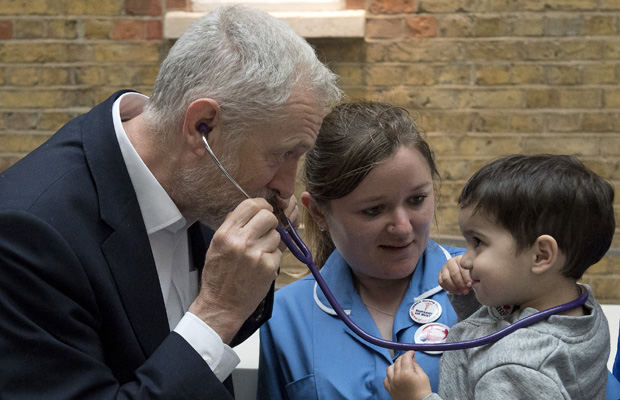Labour, the Tories and the Liberal Democrats all came out with their manifestos this week.
As you’d expect, each party is keen to prove that theirs is the right vision for Britain at this time of national turmoil.
There are some partisan jibes and a fair bit of self-congratulation from all sides. But behind the rhetoric, is there any real difference in what the three parties offer voters?

Who do you want to be your next Prime Minister?
The Conservative manifesto never actually mentions Jeremy Corbyn, but Theresa May’s constant refrain of “strong and stable leadership” suggests that she wants this election to be about personalities, not parties.
In fact, the word “Conservative” has been missing from Mrs May’s campaign banners this time.
The Labour manifesto makes no secret of its contempt for Tory policy, but avoids hand-to-hand combat with May.
This could be because – as we noted in a recent FactCheck video – pollings suggests Mrs May’s personal appeal to voters crosses party lines.
The Liberal Democrats have taken a novel approach. Their leader, Tim Farron, explicitly states that he is not auditioning for the role of Prime Minister and that the Tories are “on course to win this election”. Their pitch is not to be the party of government, but to usurp Labour as Her Majesty’s Official Opposition.
The Tories might be right that this election will be decided on personalities. But let’s put aside the leaders’ aspirations for a second, and consider what the parties have to say on three key policy areas – Brexit, health and social care, and taxes.
Brexit
The Lib Dems are the only party of the three to propose a second EU referendum – this time on a future Brexit deal.
They accuse Labour of “holding Theresa May’s hand as she jumps off the cliff edge of a hard Brexit”, and say they want to fight to retain the UK’s membership of the single market and customs union.
Though they wouldn’t admit it, Labour and the Conservatives appear to agree on the main elements of “hard” Brexit.
Theresa May openly declared that she wants to leave the single market, and the customs union, and end freedom of movement of EU citizens.
Labour are less explicit, but the result is much the same. They say that their “emphasis is on retaining the benefits” of the customs union and single market, but make no mention of trying to stay part of those structures.
Labour state plainly that “freedom of movement will end when we leave the European Union”, and that seems to settle the matter.
Both Labour and the Tories have ruled out a referendum on the negotiated Brexit deal.
FactCheck verdict: Labour and the Tories appear to be in broad agreement on a hard Brexit, though Labour are less forthcoming about their plans.
The Lib Dems want to stay in the single market and the customs union, and are the only party offering another referendum. They are seeking a softer Brexit than the other two.

Health and social care
All three parties say they will spend more money on the NHS. Labour say they would spend the most: injecting more than £30 billion over the next parliament.
The Lib Dems promise to create a pot of £6 billion per year for five years (which would also total £30 billion in the period), although that money would not just be for the NHS alone – it would be split between health and social care.
The Tories lag behind, saying they’ll spend £8 billion in total over five years.
They haven’t shared all the details with us on this and, as we pointed out yesterday, the party has a history of creative reporting when it comes to NHS spending commitments.
The Lib Dems want to remove the pay freeze for NHS workers, as do Labour – both will remove the pay cap for the public sector. The Tories haven’t said anything on public sector pay, so we are assuming they’d keep the cap in place.
The Tories have said that they would change the way that social care is funded: if you’re cared for at home and the combined value of your savings and property is over £100,000, you will have to pay for your own care.
This is in stark contrast to the Lib Dem and Labour proposals. Labour wants to create a National Care Service with £8 billion in funding over five years.
The Lib Dems are promising to spend some of the £6 billion they have allocated to health and social care on looking after the elderly.
FactCheck verdict: Labour and Lib Dems say they would spend a lot more on the NHS than the Conservatives.
And they both say they’ll spend more on social care over the next parliament.
The Tories want tougher rules on how existing funding is spent, and have not committed any further money.
Taxes
The Lib Dems are the only party proposing an income tax rise for everyone earning over the Personal Allowance threshold (currently £11,500). They propose an increase of 1p in every pound of taxable income, and plan to use the revenue to fund health and social care.
Labour have promised no income tax rises for anyone earning less than £80,000, and no rise in VAT or personal National Insurance Contributions.
They will increase income tax for those earning over £80,000 and raise Corporation Tax, although smaller businesses will pay a lower rate. FactCheck crunched the numbers earlier this week – we’re not sure this will bring in as much money as Labour think.
The Tories have matched Labour’s promise not to raise the rate of VAT, but otherwise have offered very few hard figures on how taxes might change in a Conservative administration.
They have reiterated a few of their existing commitments. Otherwise, their tax plan is simply a broad intent to “reduce taxes on Britain’s businesses and working families”.
FactCheck verdict: Under the Lib Dems, nearly everyone takes a small hit. Under Labour, 95 per cent of people won’t see their taxes go up, but businesses will suffer. The Tories want to lower taxes overall, but haven’t committed to anything concrete.
So do voters have a real choice at this election?
That depends on what you think is the most important issue. If Brexit is your main priority, then the Lib Dems are offering policies that are genuinely distinct from Labour and the Tories.
The only problem is that even they don’t expect to be in government to enact them. (Although that doesn’t mean they can’t be an effective parliamentary opposition, of course).
On health, social care and taxation, there are a range of options on the table.
Labour would raise taxes the most overall, and spend the most on the public sector.
The Lib Dems would spend a little less, and raise taxes more evenly between groups.
The Tories have yet to spell out their full tax plan, but we know they will spend significantly less than Labour across the board.
We expect to learn more about the detail of how spending could change under these different plans when the Institute for Fiscal Studies publish their manifesto analysis next week.
Update: we have updated the article to clarify that both Labour and the Liberal Democrats want to remove the public sector pay cap.



